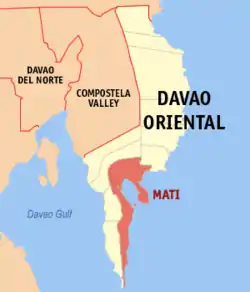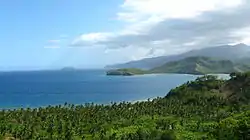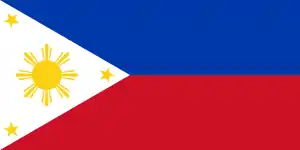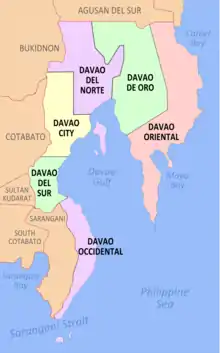Mati, Davao Oriental
Mati, officially the City of Mati (Cebuano: Dakbayan sa Mati; Tagalog: Lungsod ng Mati), is a 5th class component city and capital of the province of Davao Oriental, Philippines. According to the 2015 census, it has a population of 141,141 people.[5]
Mati | |
|---|---|
| City of Mati | |
 Capitol Hill | |
 Seal | |
| Nickname(s): Coconut Capital of the Philippines | |
 Map of Davao Oriental with Mati highlighted | |
OpenStreetMap 
| |
.svg.png.webp) Mati Location within the Philippines | |
| Coordinates: 6°57′N 126°14′E | |
| Country | |
| Region | Davao Region (Region XI) |
| Province | Davao Oriental |
| District | 2nd District |
| Founded | 1861 |
| Chartered | 1903 |
| Cityhood | June 16, 2007 |
| Barangays | 26 (see Barangays) |
| Government | |
| • Type | Sangguniang Panlungsod |
| • Mayor | Michelle Marie Denise N. Rabat (PDP-LABAN) |
| • Vice Mayor | Ma. Glenda Monette S. Rabat-Gayta (UNA) |
| • Representative | Joel Mayo Z. Almario |
| • Electorate | 85,289 registered voters (2019) |
| Area | |
| • Total | 588.63 km2 (227.27 sq mi) |
| Elevation | 98 m (322 ft) |
| Population | |
| • Total | 141,141 |
| • Density | 240/km2 (620/sq mi) |
| • Households | 31,853 |
| Demonym(s) | Matinians |
| Economy | |
| • Income class | 5th city income class |
| • Poverty incidence | 18.71% (2015)[4] |
| • Revenue | ₱554,365,581.78 (2016) |
| Time zone | UTC+8 (PST) |
| ZIP code | 8200 |
| PSGC | |
| IDD : area code | +63 (0)87 |
| Climate type | tropical rainforest climate |
| Native languages | Davawenyo Surigaonon Cebuano Kalagan Kamayo Tagalog |
| Website | mati |
It is located on the south-eastern side of Mindanao.
Barangays
Mati is politically subdivided into 26 barangays. In 1957, the barrio then known as Cabuaya was renamed to Dawan.[6]
- Badas
- Bobon
- Buso
- Cabuaya
- Central (City Proper/Poblacion)
- Culian
- Dahican
- Danao
- Dawan
- Don Enrique Lopez
- Don Martin Marundan
- Don Salvador Lopez, Sr.
- Langka
- Lawigan
- Libudon
- Luban
- Macambol
- Mamali
- Matiao
- Mayo
- Sainz
- Sanghay
- Tagabakid
- Tagbinonga
- Taguibo
- Tamisan
Etymology
Mati comes from the Mandayan word Maa-ti which refers to the town's creek that easily dries up even after heavy rain. Pioneer settlers were tribes Kalagan, Mandayan, and Maranao which carried strong Arabic and Indo-Malayan influences.
History

Spanish period
Captain Prudencio Garcia, the pioneer political-military head in 1861, and his comrade Juan Nazareno founded Mati and two other towns in Davao Oriental.
American period
By 1903, Mati was declared a municipality by virtue of Act No. 21. By 1907, Act No. 189 further reaffirmed the establishment of its local government. Francisco Rojas was the first appointed mayor while the first elected mayor was Patricio Cunanan in 1923. Mati became the capital of Davao Oriental in 1967.
Japanese occupation and World War II
The Japanese Imperial forces landed in town and occupied most of eastern Davao region in 1942. Mati was liberated in 1945 by the Allied Philippine Commonwealth troops of the 6th, 10th, 101st, 102nd, 103rd, 104th, 106th, 107th and 110th Infantry Division of the Philippine Commonwealth Army, 10th Infantry Regiment of the Philippine Constabulary and the Davaoeño guerrilla units.
Contemporary Period
Mati celebrated its grand centennial in 2003.
Cityhood issues

On June 20, 2007, the Commission on Elections officially proclaimed the ratification of Republic Act 9408 converting the Municipality of Mati into a component city.
There were 18,267 actual voters out of the 51,287 registered voters in 26 villages and 266 polling precincts during the June 18 plebiscite. Final tabulation showed Yes – 18,267 votes (35.6%); No – 846 (1.6%).[7]
Demographics
Mati is the fifth largest city/municipality in Davao Region, after Davao City, Tagum, Panabo, and Digos.[8]
| Year | Pop. | ±% p.a. |
|---|---|---|
| 1903 | 1,365 | — |
| 1918 | 7,649 | +12.18% |
| 1939 | 10,200 | +1.38% |
| 1948 | 11,562 | +1.40% |
| 1960 | 23,479 | +6.08% |
| 1970 | 53,242 | +8.52% |
| 1975 | 73,125 | +6.57% |
| 1980 | 78,178 | +1.34% |
| 1990 | 93,023 | +1.75% |
| 1995 | 93,801 | +0.16% |
| 2000 | 105,908 | +2.64% |
| 2007 | 122,046 | +1.98% |
| 2010 | 126,143 | +1.21% |
| 2015 | 141,141 | +2.16% |
| Source: Philippine Statistics Authority [3] [9] [10][11] | ||
Ethnicity and Languages
Cebuano is the most widely spoken language and the corresponding ethnicity (which includes the Boholano subgroup) accounts for 71.55% of the total household population according to a 2000 census. Mandaya ranks second with 12.74%, followed by Kalagan with 6.87%. Most residents of Mati are descendants of migrants from the Visayas who came for employment opportunities in logging, mining, farming, fishing, trading and teaching.[12]
Religion
Roman Catholicism is the major religious group, comprising the 80% of the total population. Islam comes in second with 8 percent, Iglesia Ni Cristo comes in third comprising with 6 percent. A small number of believers of other Christian groups like the United Church of Christ and Seventh Day Adventist are in the city as well.[12]
The Cathedral of San Nicolas de Tolentino is the center of Diocese of Mati under the jurisdiction of Roman Catholic Archdiocese of Davao. Two parishes are in Mati: one in the town center and one in Barangay Dawan.[13]
Climate
| Climate data for Mati City | |||||||||||||
|---|---|---|---|---|---|---|---|---|---|---|---|---|---|
| Month | Jan | Feb | Mar | Apr | May | Jun | Jul | Aug | Sep | Oct | Nov | Dec | Year |
| Average high °C (°F) | 29 (84) |
29 (84) |
30 (86) |
30 (86) |
30 (86) |
29 (84) |
29 (84) |
29 (84) |
30 (86) |
30 (86) |
29 (84) |
30 (86) |
30 (85) |
| Average low °C (°F) | 22 (72) |
22 (72) |
22 (72) |
23 (73) |
24 (75) |
24 (75) |
24 (75) |
24 (75) |
24 (75) |
24 (75) |
24 (75) |
23 (73) |
23 (74) |
| Average precipitation mm (inches) | 168 (6.6) |
141 (5.6) |
143 (5.6) |
141 (5.6) |
216 (8.5) |
235 (9.3) |
183 (7.2) |
169 (6.7) |
143 (5.6) |
176 (6.9) |
226 (8.9) |
168 (6.6) |
2,109 (83.1) |
| Average rainy days | 22.1 | 18.5 | 21.7 | 22.5 | 27.8 | 28.1 | 27.4 | 26.6 | 24.7 | 26.3 | 26.5 | 24.9 | 297.1 |
| Source: Meteoblue [14] | |||||||||||||
Economy
This region is linked to the markets of Mindanao, Malaysia and Indonesia. Most of the local people rely on agriculture and agro-industries for a living. Exports include bananas, pineapples, coconuts and fish. Because of its tropical nature and beaches, tourism is a rapidly growing business. Mining is also a contributor to the city's economy, due to the large deposits of copper in the city outskirts.[15]
Industry
Utilities
Mati is served by the Davao Oriental Electric Cooperative for its power needs. The Mati City Water District, on the other hand, is the local water provider for the city.
Tourism

Mati offers beautiful landscapes and a number of beautiful resorts. The Provincial Capitol building and park rises atop the hill commanding a fantastic view of the Pujada Bay. Other locations that offer a bird's-eye view of the city are the Mati Tourism Complex and Badas Viewdeck.
Dahican Beach
Mati has always been known as a beach destination, with foreigners flocking to the city to enjoy what its beaches have to offer. Dahican is one of the most popular destinations in Mati with its 2-kilometer pure, fine white sand shore. It has recently become a prime destination for surfers and skimboarders. Pujada Bay boasts thousands of species of sea life and has been considered as among the richest bays in Southeast Asia. As such, locals take measures to preserve the diversity of marine life, protecting animals like lobsters, sea cows (locally known as Dugong), bottlenose dolphins, hammerhead sharks, manta rays and different kinds of turtles.
Recently, skimboarding, surfing, and frisbee sports have established a wide fandom among young locals with Dahican being the favorite hub for tournaments in the region.
Mati is home to three protected areas, the Mount Hamiguitan Range Wildlife Sanctuary, Mati Protected Landscape, and Pujada Bay Protected Landscape and Seascape.
Mindanao SAGA Flying Club

The Mindanao SAGA Flying Club (MSFC), located at the Mati National Airport in Barangay Dahican, is an Ultralight aircraft flying facility that offers trial flights and flying lessons. Fast becoming the major attraction in Mati, MSFC has introduced a safe, affordable, and an exciting way to see the majestic scenery of the city like no one has seen before. The Quicksilver Sport 2S ultralight is the favorite of visitors owing to its open cockpit that gives the passenger an unrestricted view of the landscape and the feeling of ultimate freedom in the air.

Subangan Museum
Inaugurated in January 2014, Subangan is the provincial museum. It features interactive, state-of-the-art exhibits. The centerpiece is a 53-feet skeleton of a sperm whale, considered the largest on display in the whole country. The museum also features exhibits on UNESCO World Heritage Site Mount Hamiguitan and Davao Oriental's history.[16]
Culture and Festivals
Mati celebrates two annual grand festivals: the Pujada Bay Festival every June, and the Sambuokan Festival every October. Compared to the Kadayawan of Davao and other festivals, both of Mati's are relatively new. The Pujada Bay Festival started in 2004 to promote and protect the Pujada Bay, while the Sambuokan Festival started in 2001 to unite Matinians during the commemoration of the municipality's founding anniversary every October 29. In years, both festivals have become alternative tourist destinations as competitors from various regions in the country start pouring in for competitions like streetdancing, boat racing, skimboarding, and frisbee.
Education
Mati City is the educational center of the province of Davao Oriental. The state university of the province, the Davao Oriental State University, is in Dahican, as is the Davao Oriental Regional Science High School. There are two other colleges in the city: Mati Polytechnic College and Mati Doctors College.
In basic education, seven private schools, sixteen public high schools, and a number of public elementary schools are located in the city.[17] The City Schools Division of Mati supervises these schools.
Transportation
The pedicab or tricycle is the major means of transportation around the city. In recent years, underbone motorcycles have earned quite a popularity among professionals and students, thus easily becoming a public transport alternative to commuters who prefer more speed. Jeepneys are available for travels from Mati to its neighboring towns while vans and buses are still the only means of transportation from Mati to other cities.
Mati Airport is scheduled to operate, with Cebu Pacific offering Mati-Cebu direct flights.
There is also a seaport in Mati. The Mati Seaport in Pujada Bay is one of only three seaports in the whole province of Davao Oriental.
Sister cities
 Tagum, Davao del Norte
Tagum, Davao del Norte
References
- City of Mati | (DILG)
- "Province: Davao Oriental". PSGC Interactive. Quezon City, Philippines: Philippine Statistics Authority. Retrieved 12 November 2016.
- Census of Population (2015). "Region XI (Davao Region)". Total Population by Province, City, Municipality and Barangay. PSA. Retrieved 20 June 2016.
- "PSA releases the 2015 Municipal and City Level Poverty Estimates". Quezon City, Philippines. Retrieved 12 October 2019.
- "Philippine Standard Geographic Code (PSGC) | Philippine Statistics Authority". psa.gov.ph. Retrieved 2019-07-13.
- "An Act Changing the Name of the Barrio of Cabuaya, Municipality of Mati, Province of Davao, to Barrio Dawan". LawPH.com. Retrieved 2011-04-12.
- Sun.Star Davao - Mati now a city Archived 2007-06-30 at the Wayback Machine
- "Population of Region XI - Davao (Based on the 2015 Census of Population)". Philippine Statistics Authority. Retrieved 27 March 2017.
- Census of Population and Housing (2010). "Region XI (Davao Region)". Total Population by Province, City, Municipality and Barangay. NSO. Retrieved 29 June 2016.
- Censuses of Population (1903–2007). "Region XI (Davao Region)". Table 1. Population Enumerated in Various Censuses by Province/Highly Urbanized City: 1903 to 2007. NSO.
- "Province of Davao Oriental". Municipality Population Data. Local Water Utilities Administration Research Division. Retrieved 17 December 2016.
- "About". Official Website of the City of Mati. Retrieved 21 April 2014.
- "Parishes and Parochial Clergy - Diocese of Mati". CBCP Online. Retrieved 16 March 2017.
- "Mati City: Average Temperatures and Rainfall". Meteoblue. Retrieved 18 November 2019.
- "Mati Travel Guide, Philippines | Travelgrove.com". travelgrove.com. Retrieved March 30, 2011.
- Tacio, Henrylito. "Touring Davao Oriental's Subangan Museum". Rappler. Retrieved 16 March 2017.
- "Mati City Public High School". Philippines Schools. Retrieved 16 March 2017.
External links
| Wikimedia Commons has media related to Mati City. |
| Wikivoyage has a travel guide for Mati. |
